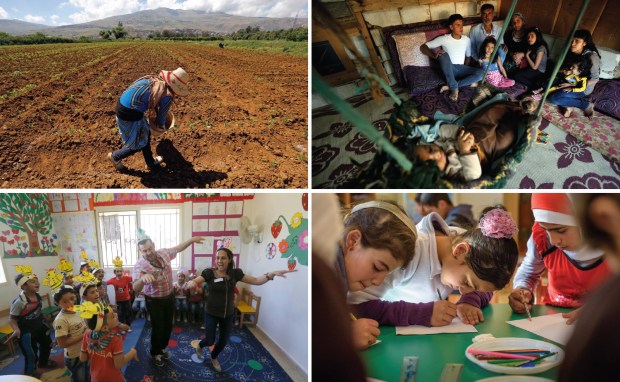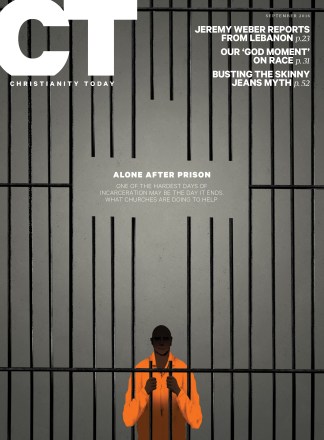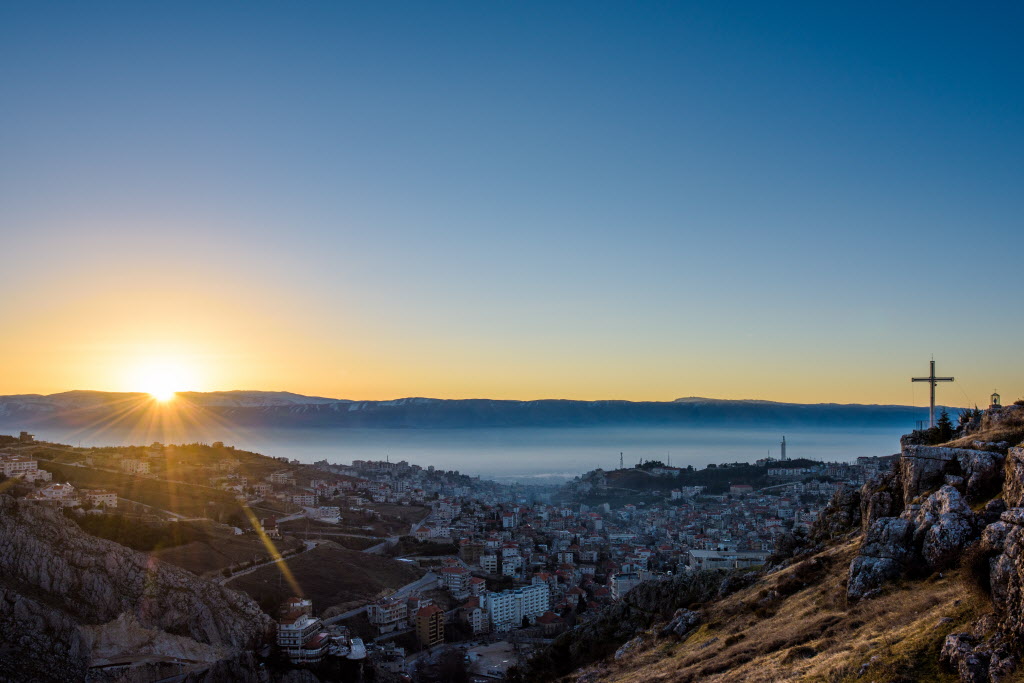Faysal stands amid the rolling fields of the Bekaa Valley. Just down the road are award-winning, decadent vineyards—a product of the fertile agricultural region’s 5,000-year head start on Napa Valley. The Romans even chose to build their temple to Bacchus here. Above loom the snow-covered slopes of Mt. Hermon, where many today place Jesus’ transfiguration.
Surveying the sea of green plants rustling in a pleasant breeze, the 43-year-old describes what he feels: “A knife in my heart.”
For Faysal, a Syrian refugee, the scene is not one of grandeur but of guilt; in the field before him are three of his children—his 15-year-old son and 13- and 11-year-old daughters—bent in half as they weed potatoes instead of attending school.
“I have no choice,” says the father of six. In Aleppo, one of Syria’s most war-torn cities, his job as a truck driver once provided a four-room house and a middle-class, urban life. Now, having injured his back in his own efforts at day labor, he can’t pay the rent for their cobbled-together shelter on a farmer’s property. So he just stands and watches his children. And cries.
“As a father, what is the purpose of my life if I can’t provide for my children?” he says. “I’m ashamed of the present and the future.”
On the shores of the Mediterranean Sea just north of Israel, Lebanon once enjoyed a reputation as the Switzerland of the Middle East, a land of milk and honey. On the eve of Ramadan, Christianity Today visited with World Vision to witness how the Bekaa Valley now recalls John Steinbeck’s Great Depression–era description of the Dust Bowl and California. In the Bekaa, many refugees struggle to survive as tenant farmers, as did the Joads of The Grapes of Wrath. But unlike the Joads, many used to be urban, middle-class families.

While Americans agonize over plans to resettle 10,000 Syrian refugees this year, Lebanon is straining under the weight of 1.5 million. And it’s a nation of only 4.5 million, smaller than Connecticut and with fewer people than Kentucky.
Today, 1 in 3 people in Lebanon is a refugee. As a Beirut taxi driver put it: “Now you fear that when you go home, you will find a refugee sleeping in your bed.”
On the Corniche, Beirut’s famed boardwalk perfect for watching the sun set over the Mediterranean, most of the evening crowd are not Lebanese or tourists, but Syrian refugees. Families fill the mosaic-covered benches while men fish for dinner from the algae-covered rocks at the seawall’s base. Stretching along the coast is the long ridge of Mount Lebanon. Its dense clusters of terraced white houses evoke snow-covered slopes even in the summer heat.
These days, most of the street vendors on bustling Hamra Street, one of Beirut’s main tourist strips for shopping, are refugees. At Cafe Younes, open since 1935 and famous for its specialty coffee roasts and the cigar-smoking communists always on hand to drink it, a dirt-streaked boy navigates the sidewalk tables in the leafy shade. About six years old, he is raggedly dressed in the colors of the Syrian flag: a red polo shirt, black pants that stop well above his ankles, and white-striped sneakers.
He repeatedly gestures to his mouth, saying “C’mon please” as he peddles green and yellow packs of Chiclets gum. Three sidewalk tables decline before two shoppers in a black Audi across the street finally say yes. A few minutes later, a girl around age eight with her hair in a frazzled braid starts retracing the boy’s path with just a bare, outstretched hand.
Lebanon does not permit official refugee camps—a vestige of its refusal to accept its many Palestinian refugees from Israel as permanently displaced. So, many Syrians settle in what aid workers call “informal tent settlements” (ITS). Most hold one or two dozen families; the largest has about 100 families. Landowners in the Bekaa charge about $200 per month; most families reluctantly have their children work the farm as payment.
The Bekaa was the main feature of the in-flight magazine of Lebanon’s national airline when CT visited. Indeed, its sprawling vineyards and fields surrounded by dusty mountains evoke the scenic Napa Valley. But it’s a Napa dotted with military checkpoints, mosques, and tent cities. Open-air trucks can be seen taking day laborers to the fields; they ferry more workers than usual because the truck beds are packed with children.
The farmer supervising Faysal’s children explains that before Syria’s civil war, the field hands in the Bekaa were only 20 percent Syrians, and all were 15 or older. Today, 100 percent are Syrians, and even six-year-olds can be found in the fields. The children work a five-hour shift for $3. They do two shifts a day.
“It wounds me deep in my heart to see the child labor,” says the farmer, himself a father of three. It’s also inefficient: “A 6-year-old cannot carry as many potatoes as a 15-year-old.” But he says offering them work is better than their parents having no way to pay rent.
Hours later, Faysal and the children host World Vision guests in their tent, No. 11 in an oval of 26 jury-rigged shelters the size of American mobile homes. The mother, Hivin, explains how the family was displaced from Aleppo when life became too hard. First they could not get bread or other food due to blockades. Then their house was bombed. They’ve been displaced in Lebanon for three years now.
Hivin, 34, rests her 18-month-old daughter, Elva, on her knee while her youngest, 4-month-old Youssef, is asleep in the next room. Both were born in the tent.
“Many people ask, ‘Why get pregnant during such troubles?’ ” she says. “I wanted a brother for my oldest boy. We don’t want to stop our lives.”
 Bilal Jawich
Bilal Jawich
Yet much has stopped. She recalls how her teenage son, Abdo, loved school so much, he would fall asleep holding a textbook in his hands. The family paid for a private driver to take their children to school. Now the siblings are years behind. They crowd with a dozen other children between their World Vision–built latrine and front door around a small board donated by a church, and give each other impromptu lessons learned from World Vision. They snack on the leftover peas that their mother shells in order to earn $1 a day.
“Every time I send them to work in the fields, I cry,” says Hivin. “But I don’t cry in front of them. I act strong.” She tells them that working in the fields is a better fate. If they had stayed in Syria, her son would have been kidnapped and the girls would have been abused, she says.
Their 11-year-old daughter, Nisreen, the second oldest of the four sisters, comes into the room wearing rose sunglasses and gold bangles. One would have no idea that hours before, she was weeding potatoes. “It’s tough, and I get exhausted and dirty,” she says. “But I want to help my father pay for food. It’s okay that I get exhausted, because he is exhausted too.”
In a nearby ITS lives another Syrian family that also fled Aleppo nearly four years ago. A 25-year-old mother of three, Leila tearfully explains how she lies to her parents, saying that they live in a house like their old one, with multiple rooms and a kitchen. In reality, she, her husband, and their children (ages eight, six, and three) live in a tent city with cockroaches and mice, accessible only through the field where she harvests zucchini.
“When my parents ask for photos of the kids playing in our house, I find 100 reasons not to send the photo,” she says, grabbing tissues from a black and red box that matches her jacket and headscarf and evokes Syria’s flag.
While CT interviews her, word comes that her eight-year-old son, Hasan, has been beaten up while playing soccer. “See what I mean?” she says. “Such situations make me say I won’t stay in this tent one extra minute. But when you think about other options, you just shut your mouth and sit back down.”
Leila and her husband, who paints cars for income, have agreed that risking their lives on the journey by boat across the Mediterranean to Europe is not worth the risk.
 Jon Warren / World Vision
Jon Warren / World Vision
Yostinos Boulos Safar, the Syriac Orthodox archbishop of Zahle (the Bekaa’s second-largest city), estimates that one-third of the hundreds of families who have passed through his diocese since 2011 have chosen to try the illegal sea route. He knows of at least a dozen who drowned.
“It’s a difficult decision, but it’s coming from their suffering,” says Safar. “If you want to stay, we will do our best to help you. If you want to leave, we can’t stop you.” His church helps hundreds of families with housing and education. “But it is not enough.”
One example: On a busy street corner, up two flights of stairs lined with potted plants, lives Budur, a 27-year-old Syrian mother of five. Her family fled Homs after neighbors were kidnapped and bombs hit their street. She also has given birth while displaced—to twins, now two. “It is true that we are refugees, and that we are still displaced,” she says. “But we need to continue in any way possible.”
However, the births were difficult and the family incurred a lot of medical debt. So months later, Budur decided to have her husband, Johny, cross the sea to Europe. He finally made it to Germany, but only after he “saw death” four times. Johny’s been gone nearly two years, waiting for legal status, so still no remittance for Budur—or means to join him.
“A large part of my life is missing. I am doing everything I can, but I’m exhausted, dividing myself into too many parts: working, raising the children, taking care of the house,” she says. “What I put in front of my eyes when I feel sad is the image of him safe and secure. And the idea that he may take us with him one day.”
Safar says many refugees in tents think the ones in houses are living well, while many refugees in houses think the ones in tents are receiving more aid from NGOs. “Both groups have needs and challenges in their own way.”
And don’t overlook the Lebanese, he says. With about 300,000 Lebanese in the Bekaa now competing with about 400,000 Syrian refugees for work, Safar says many Lebanese are also struggling because they can’t compete with Syrians who work for lower wages or whose businesses don’t pay taxes.
“Some aid groups think of the refugees as the only ones with problems,” he says. “It is our duty as a church and as Christians; Jesus said you have to help everybody who comes to you. But both of us are suffering. We have to find a solution for both of us.”
The crisis has deeply impacted Lebanon’s churches. “Every church that has shown compassion for Syrian refugees has been overwhelmed with their presence,” says Martin Accad, director of the Institute of Middle East Studies (IMES) at Arab Baptist Theological Seminary in Beirut. Most have added more services, where headscarves—previously unseen on Sundays—now dot the crowd. “It’s become like the Lebanese version of America’s ‘seeker-friendly’ movement,” he says. “You’re not required to be committed to Christianity to be part of the church.”
Accad believes that most churches are communicating that receiving charity is not a reward for church attendance. His bigger concern: that in the “whirlwind of relief work,” Lebanese churches will lose their spiritual focus.
“It’s important for churches to not forget that they are a church,” says Accad. “We can objectify refugees when we try to function like an NGO. The church should remain the church.”
This summer, IMES gathered 230 experts in its largest-ever consultation of Middle Eastern churches on how to balance the needs of refugees with building the body of Christ. One takeaway for Western churches: Welcome the refugees in limbo in Europe or North America. “Waiting for papers, they are very lonely, out of their element, with a deep need for community,” says Accad. “If left alone, they risk radicalization.”
“The most important thing churches can do is to be hospitable,” he says. “This fear of ISIS infiltration is rubbish. The church is called to be hospitable, regardless of consequences. And when churches are the church to refugees, they are actually preventing the greatest fear we have of refugees: radicalization.”
 Jon Warren / World Vision
Jon Warren / World VisionAmong the many NGOs working to address such concerns in the Middle East is World Vision, a leader in offering Child-Friendly Spaces (CFS). There, refugee children can get an education and psychological support.
At one CFS in the Bekaa, about two dozen Syrian children sport handmade paper hats—bumblebees for the boys and butterflies for the girls—as they sing a song about the winged insects. Taped on the wall by the door is a cardboard spinning wheel of cartoon faces showing different emotions. Each day, when the children come from their shift in the fields, they select the face that corresponds with how they feel. They repeat the exercise when they leave the CFS.
The teacher, Mohammed, a 33-year-old Syrian refugee, says most pick “sad,” “angry,” or “anxious” faces. He hopes they will pick “happy” by the time they leave.
Children attend the CFS for three months, then are rotated out for a new batch due to the large number of at-risk youth. During class they color, sing, and play—all to help them process their feelings and develop resilience.
“Even though they are working in the fields, this center can make them remember that they are children,” says Mohammed. “At first, some don’t talk. Some only fight with others. Over time, they become kids again.”
These children are halfway through the cycle. When they arrived, their drawings were of bombs destroying houses; today they are drawing the CFS in lots of happy hues. They switch from the silly song about bees and butterflies to an earnest song that is equal parts patriotism and plea. A rough translation:
You children of the world, look at us.
We are the children of Syria.
Our future is in your hands.
We call for you to help us and protect us,
So we can grow like the grass.
As the Syrian conflict stretches from year to year, such sentiment becomes harder to muster. But with the aid of World Vision and Lebanese churches, Syrian refugees are clinging to hope.
 Jon Warren / World Vision
Jon Warren / World Vision
Back in Budur’s sparse apartment, above her head on the wall is one of the few objects she brought from Syria: a black cross made of seven pieces of wood connected by small chains. It is a metaphor for her family of seven: separated, yet still hanging together.
Inscribed on the cross is the Lord’s Prayer. Its familiar words of “daily bread” and “thy will be done” have become poignant. “Despite passing through such hard moments, our faith remains strong,” she says. “We live day by day. But we know that Jesus is next to us.”
Jeremy Weber is CT senior news editor.
To get involved, visit worldvision.org/refugees and wewelcomerefugees.com.















